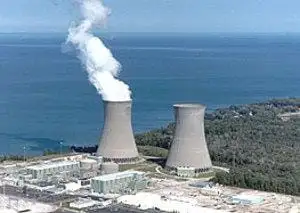Methane could be storage solution for solar, wind
That may be good news for wind and solar power enthusiasts, who have long been faced with the dilemma of how to store energy when the wind isn't blowing and the sun isn't shining. This discovery opens the door for generating methane from those renewable power sources; the energy could then be stored as fuel for later use.
But is storing renewable energy in the form of a greenhouse gas like methane a solution, or just another problem?
The remarkable microbe, Methanobacterium palustre, is the first to be found which can biochemically synthesize methane using electrons directly from current in combination with hydrogen gas. Most significantly, it appears to transform the energy at 80% efficiency. That's pretty darn good, according to researchers.
Before this discovery, the options were limited regarding how to store energy generated from wind or solar sources. Storing it in large capacitors and batteries offered the most practical solution, since converting the energy into a fuel like hydrogen made it difficult to compress and store. But that problem doesn't exist for methane, which is the main component for natural gas. Natural gas is already carried around the world in pipelines, and it's used in conventional engines.
Though despite the good news, utilizing this process may overlook some of the bigger reasons for switching to renewable energy. Specifically, if the primary benefit for using wind and solar energy is to reduce greenhouse gas emissions, then wouldn't converting that energy into methane miss the point?
Yes and no. Methane is a very clean burning fuel, and compared to other hydrocarbons, burning methane produces less carbon dioxide for each unit of heat released. In other words, if the choice is between storing excess wind or solar energy as methane or having to use traditional, dirtier fuels like gas or coal to pick up the leftover energy burden, then converting clean energy into methane- while perhaps not the ideal solution- is still a significant step forward.
More research needs to be conducted to determine the exact molecular mechanism of the biochemical process, and practical means for employing the technology have yet to be worked out. But the exciting discovery does shed some creative light on the potential for renewable sources to supply all of our energy needs.
Related News

Westinghouse AP1000 Nuclear Plant Breaks A First Refueling Outage Record
NEW YORK - Westinghouse Electric Company today announced that Sanmen Unit 2, one of the world's first AP1000® nuclear power plants, has set a new refueling outage record in the global nuclear power industry, completing its initial outage in 28.14 days.
"Our innovative AP1000 technology allows for simplified systems and significantly reduces the amount of equipment, while improving the safety, reliability and economic efficiency of this nuclear power plant," said Gavin Liu, president of the Westinghouse Asia Operating Plant Services Business. "We are delighted to see the first refueling outage for Sanmen Unit 2 was completed in less than 30 days.…




